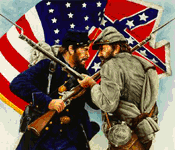 |
Civil War Battles |
|
State War Records |
| AL - AK - AZ - AR - CA - CO - CT - DE - FL - GA - HI - ID - IL - IN - IA - KS - KY - LA - MA - MD - ME - MI - MN - MS - MO - MT - NE - NV - NH - NJ - NM - NY - NC - ND - OH - OK - OR - PA - RI - SC - SD - TN - TX - UT - VT - VA - WA - WV - WI - WY |
The Battle of Deep Bottom (Second)
August 13-20, 1864 in Henrico County, Virginia
 |
|||||||||||||||||||||
|
During the night of August 13-14, the Union II Corps, X Corps, and Gregg's cavalry division, all under command of Maj. Gen. Winfield Scott Hancock, crossed James River at Deep Bottom to threaten Richmond, coordinating with a movement against the Weldon Railroad at Petersburg.
On August 14, the X Corps closed on New Market Heights while the II Corps extended the Federal line to the right along Bailey's Creek. During the night, the X Corps was moved to the far right flank of the Union line near Fussell's Mill.
Birney's movement was delayed by difficult terrain for most of August 15 and Hancock's plan for an early morning attack had to be abandoned. They reached Fussell's Mill around 1 p.m. and Birney spent the entire afternoon performing a reconnaissance while his men recovered from their march. After this, Birney judged that it was too late in the day to attack.
Early on the morning of August 16, Gregg's cavalry swept to the right to Glendale and then rode northwest on the Charles City Road toward Richmond. They found Rooney Lee's cavalry division blocking the road and a full day of fighting resulted. The Union cavalrymen drove the enemy as far as White's Tavern, but were eventually pushed back to Fisher's Farm. Confederate Brig. Gen. John R. Chambliss was killed during the fighting. The infantrymen of the X Corps had a better start to the day, as Brig. Gen. Alfred H. Terry's division, led by Col. Francis Bates Pond's brigade, broke through the Confederate line. Wright's Brigade, commanded by newly promoted Brig. Gen. Victor Girardey, was hit hard and retreated, opening a significant gap. Girardey was killed by a bullet in the head while brandishing the colors of the 64th Georgia. Field later wrote, "Not only the day but Richmond seemed to be gone." The heavily wooded terrain prevented Birney and Hancock from understanding that they had reached a position of advantage and they were unable to exploit it before Field rearranged his lines to fill the gap and drive back the Federals. Col. William C. Oates led two Alabama regiments in the initial counterattack and was wounded. Robert E. Lee had arrived north of the James by this time and witnessed the action.
No fighting occurred on August 17 and a truce was called to allow the two sides to retrieve their dead and wounded. Lee planned a counterattack against the Union right for 11 a.m. on August 18, a cavalry attack on the Charles City Road accompanied by an infantry attack at Fussell's Mill. The effort was poorly coordinated and the cavalry was not ready to move until 5 p.m. Neither the cavalry nor the infantry made any significant gains before dark. That night Hancock sent a II Corps division back to Petersburg to man a part of the trench line while other units were sent from there to the Battle of Globe Tavern at the Wilmington and Weldon Railroad south of the city. By the night of August 20, having observed no more actions by Robert E. Lee, Hancock withdrew his force back over the James.
Confederate Gen. John Chambliss was killed during cavalry fighting on Charles City Road. After continual skirmishing, the Federals returned to the southside of the James on the 20th, maintaining their bridgehead at Deep Bottom.
